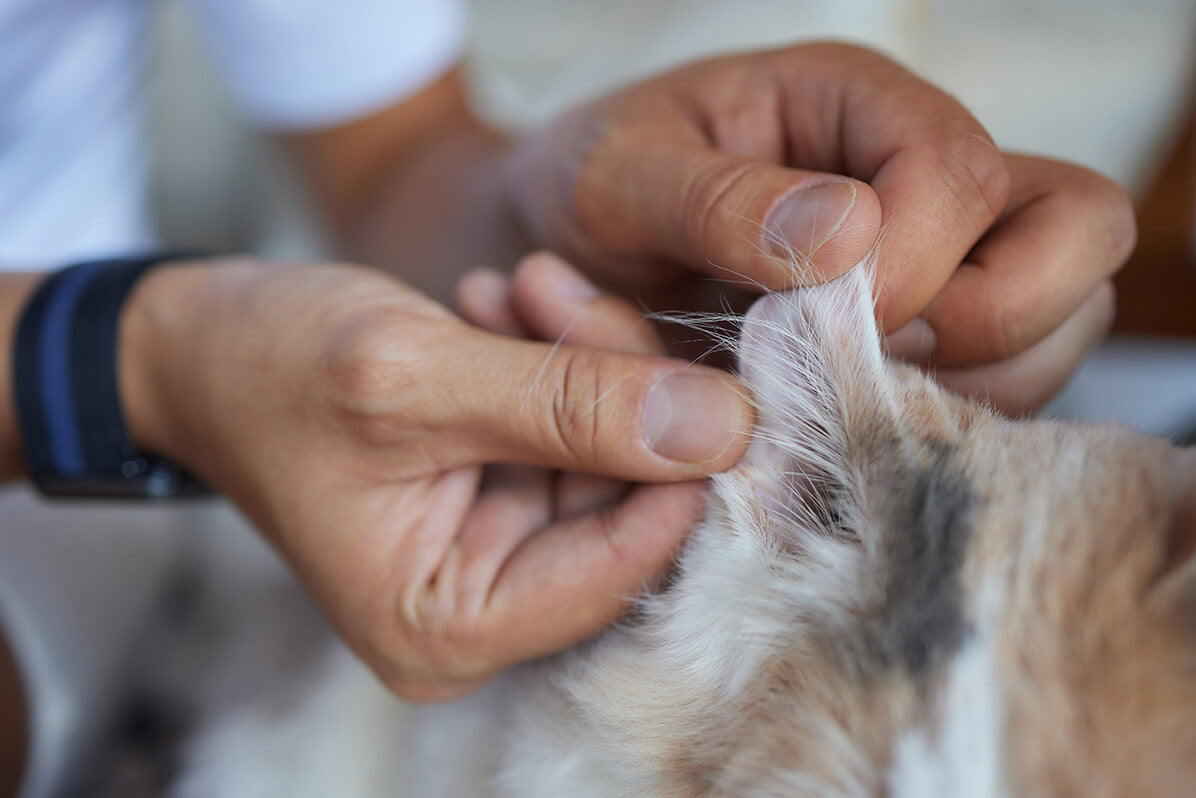
- by Dr.Thilo Senst
How to Treat Cat Ear Mites at Home: A Step-by-Step Guide
- by Dr.Thilo Senst
How to Treat Cat Ear Mites at Home: A Step-by-Step Guide
Ear mites are tiny parasites that can cause significant discomfort for your cat. Left untreated, they can lead to severe infections, hearing loss, and ongoing irritation. Fortunately, with the right approach, you can manage and even eliminate cat ear mites from the comfort of your home. This article provides a comprehensive, step-by-step guide to recognising, treating, and preventing ear mites in cats.
Ear mites are microscopic parasites, primarily Otodectes cynotis, that reside in the ear canal. These mites feed on skin oils and ear wax, causing irritation and inflammation in a cat’s ears. The presence of ear mites is more common in young cats and kittens but can affect cats of all ages.
Common symptoms of ear mites in cats include:
According to Cats Protection UK, approximately 50% of ear infections in cats are caused by ear mites, highlighting the prevalence and importance of prompt treatment.
The first step in treating cat ear mites is correctly identifying the issue. Monitor your cat for signs such as excessive scratching, black or brown discharge, and an unpleasant odour coming from the ears. If these symptoms are present, ear mites are likely the culprit.
Materials Needed:
Instructions:
After cleaning, apply a specialised ear mite treatment. There are various over-the-counter options designed for cats, such as ear drops containing natural ingredients or anti-mite agents.
How to Apply the Treatment:
Natural Remedies
For those preferring a natural approach, olive oil or coconut oil can act as mild ear mite treatments. These oils suffocate the mites and ease inflammation.
Most ear mite treatments require a repeated application to eliminate mites fully. Follow the product’s instructions for timing, as some treatments require daily application for up to two weeks.
Ear mites can live on surfaces, meaning thorough cleaning of your cat’s bedding, favourite resting areas, and toys is essential. Washing bedding in hot water and vacuuming frequently can help remove lingering mites and prevent reinfestation.
Treating ear mites at home saves on vet visits, especially for minor infections. Effective home treatments and regular ear cleaning can prevent more severe issues, reducing long-term veterinary costs.
Providing treatment to your cat yourself fosters trust. With time, your cat may become more comfortable with ear cleanings and treatments, making the process easier for both of you.
Home treatments offer instant comfort for cats, especially when itching and discomfort are managed effectively. Cleaning, soothing sprays, and ear mite solutions provide immediate relief, reducing your cat’s urge to scratch.
Cats can be sensitive to ear treatments, so remaining calm and gentle is essential. A stressed cat may resist treatment, so speak soothingly and handle them softly.
Positive reinforcement with treats after treatment can help your cat associate ear care with a rewarding experience.
If your cat is particularly anxious, Dr. Senst Cat Calming Hemp Oil for Cats may be beneficial. This calming oil is designed to relax pets, reducing stress associated with handling and grooming.
Routine ear checks can help you spot early signs of ear mites before they become a severe issue. By monitoring your cat’s ear health weekly, you can intervene at the first signs of irritation.
Brushing your cat regularly removes dirt and debris that could attract mites, especially in multi-pet households where mites can spread between animals.
A clean environment is essential for preventing ear mites. Wash bedding regularly, vacuum frequently, and keep food and water bowls clean to reduce the risk of mites and other parasites.
Ear mites can affect indoor cats as well. Mites can spread from other animals, so indoor cats are still susceptible, particularly if they come into contact with another infected pet.
While some natural remedies can relieve mild cases, severe infestations may require stronger treatments prescribed by a veterinarian. Always consult a vet if home treatments don’t yield results within a week.
Q1: Can I use dog ear mite treatments on my cat?
A: No, always use products specifically formulated for cats, as dog products may contain ingredients harmful to cats.
Q2: How long does it take for ear mites to clear up?
A: With consistent treatment, ear mites typically clear up within 2-3 weeks. However, it’s essential to follow treatment guidelines to prevent reinfestation.
Q3: Can I prevent ear mites altogether?
A: While preventing exposure is challenging, maintaining a clean environment and regular ear care routine can reduce the risk.
Q4: My cat is still scratching after treatment; what should I do?
A: If your cat continues to scratch or if symptoms worsen, consult a vet. Persistent symptoms may indicate a secondary infection that needs professional treatment.
To support your cat’s ear health, I recommend Dr. Senst Antiseptic Cat Ear Drops For Infections as a reliable option for cleaning and soothing your cat’s ears. These drops help remove debris and alleviate irritation, essential for managing and preventing ear mites. Additionally, Dr. Senst Cat Calming Hemp Oil for Cats is an excellent choice for cats prone to anxiety during treatments, helping to keep them calm and comfortable.
![]()
Enter your details & download our comprehensive 50+ page printable Dr. Senst Pet Care Planner completley FREE! - keep track of all your pet’s needs, from medical history and training to vet visits, grooming, diet, and more!










Share:
How to Prevent a Cat from Licking Its Wound: Best Solutions
Best Cat Shampoos for Allergies and Itchy Skin